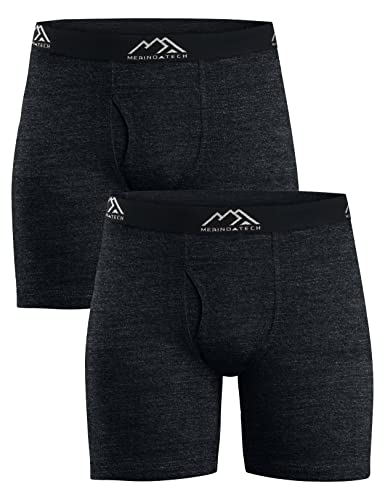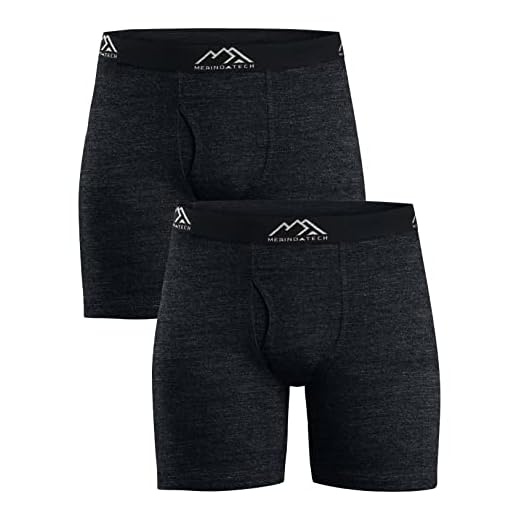
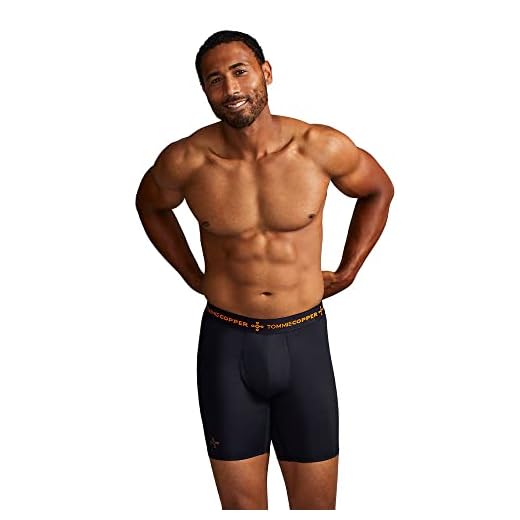
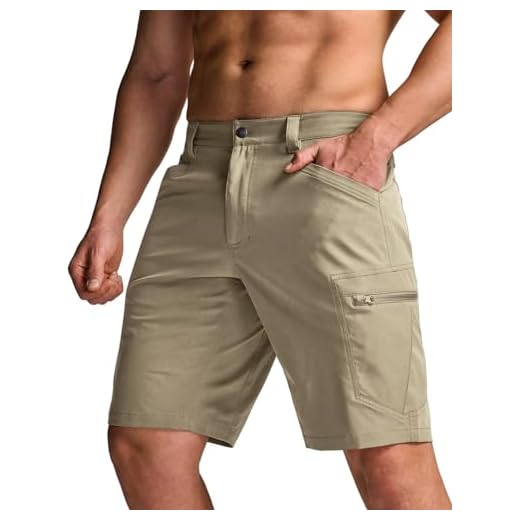
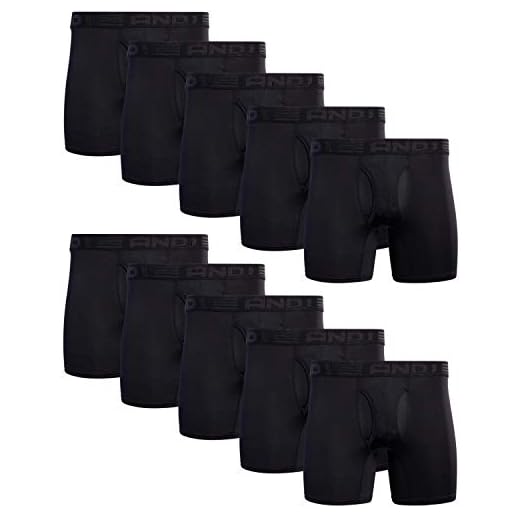
Choose 150 g/m² merino-blend boxer briefs (90% merino, 10% nylon, 3% elastane); 6–8 cm inseam; gusseted crotch; flatlock seams; 25 mm silicone-backed waistband.
Merino wool provides superior odor management, breathable thermal regulation and natural UV attenuation; a 90/10 blend increases abrasion resistance while keeping next-to-skin comfort. Typical field performance: 3–7 days of wear without significant smell under hot dry exposure when sweat levels remain moderate.
Dry times: single 150 g/m² pair dries in roughly 2–4 hours in direct sun with breeze; 100% polyester briefs dry faster (30–90 minutes) but accumulate odor more quickly across successive days. Carry two pairs when laundry opportunities are limited; carry one pair plus plan for nightly sink wash when water access exists.
Fit guidelines: snug silhouette without visible compression lines, mid-thigh length to prevent inner-thigh chafe, gusset or split-panel crotch to remove seam pressure, flatlock stitching and low-profile leg hems to cut hotspot formation during long miles. Waistband grip should be silicone-backed and ~20–30 mm wide to avoid roll-down.
Care protocol: machine wash cold or hand-wash with mild detergent, hang dry in shade to preserve fiber integrity and elastane lifespan. Avoid tumble-dry heat above 40°C and chlorine bleach; replace or refresh silicone strip when slippage appears.
Quick spec checklist: 150 g/m² merino blend; 90/10 wool/nylon; 3% elastane; 6–8 cm inseam; gusset + flatlock seams; silicone-backed waistband; UPF 15–30 rating.
Choosing fabric: breathable, quick-dry materials that resist odor
Choose a fabric mix with merino 40–70%, polyester 25–50%, elastane 3–8%; target weight 130–160 gsm; include antimicrobial finish such as silver-ion or Polygiene.
Materials comparison
- Merino – natural odor control, temperature regulation, high breathability; dries slower than synthetics; recommended inclusion 40–60% to balance comfort and drying speed.
- Polyester – rapid moisture transport, quick-dry action, high abrasion resistance; hydrophobic yarns dry ~2–3× faster than merino under identical conditions.
- Nylon – improves toughness and abrasion resistance with low bulk; typical inclusion 10–30% when durability is priority.
- Elastane – 3–8% adds stretch and fit retention; avoid >10% since excess stretch can trap moisture against skin.
- Antimicrobial finishes – silver-ion, copper, Polygiene reduce bacterial growth; expect measurable odor reduction across ~10–20 wash cycles depending on treatment specification.
Construction, care, practical tips
- Gusseted crotch plus flatlock seams minimize chafe during long moves; reduce seam count in high-friction zones.
- Mesh ventilation panels at inner thigh increase airflow; position panels where sweat accumulates to speed evaporation.
- Waistband width 25–35 mm with low-profile elastic prevents roll and reduces pressure points.
- Washing protocol: machine wash cold (30°C) with mild detergent, no fabric softener, no chlorine bleach; air dry or tumble low; avoid temperatures above 60°C which degrade antimicrobial finishes and elastane.
- Logistics: carry two spare pairs; rotate nightly wash and air-dry on pack overnight to limit odor accumulation and extend wear time.
Additional gear reference: best digital camera comparison site
Fit and inseam: preventing chafing and ride-up on long arid hikes
Choose a snug mid-thigh liner with 6–9 cm inseam, flatlock seams, gusseted crotch, and a 20–30 mm leg band with silicone gripper to minimize chafe and movement during prolonged heat-exposed treks.
Sizing metrics
Measure waist at iliac crest or at point where waistband will sit. Select size where unstretched waistband circumference equals body measurement plus 1–2 cm; elastic should allow 20–25% stretch without rolling. Measure thigh 10 cm above patella; target leg-band circumference 0.5–1.5 cm smaller than measured thigh to hold position without cutting circulation. If a compressive fit preferred, choose true body measurement with fabric that recovers 20–30% at 50% strain.
Field test and adjustments
Simulate loaded movement by wearing liner under hiking shorts while carrying a pack equal to 20–25% bodyweight. Walk 30 minutes with intermittent high-knee steps and 20 squats. Acceptable ride-up less than 5 cm from initial hem position; persistent red marks lasting longer than 10 minutes indicate excessive pressure. If ride-up occurs, increase inseam by 1–2 cm or choose a wider leg band (25–30 mm) with gripper treatment. Small tailoring fixes such as shortening inner seam by 5–10 mm or adding heat-set silicone stripe along hem can reduce migration without altering comfort significantly.
Account for shrinkage when selecting size: blends containing over 20% cotton can shrink 3–5% when washed hot, so prefer pre-shrunk models or size up one size if natural-fiber content high. Avoid liners with center-crotch seams; prefer full gusset panels and staggered seam lines away from inner-thigh contact points to lower friction and seam pressure during long days across arid terrain.
Moisture management: wicking, ventilation and sand-shedding features
Select a liner with vertical-channel inner mesh, plus front and rear laser-cut vents. Target ≥12% total vent area; prefer materials that dry under sun and wind within 20 minutes during steady exertion.
Wicking architecture
Use a smooth, low-nap outer face paired with an inner mesh that contains vertical channels 1.5–3 mm wide and 4–6 mm spacing. Channel geometry should move liquid away from skin into airflow rather than trap it. Target overall fabric areal density 90–140 g/m² to balance quick-dry speed and minimal bulk. Aim for moisture transfer times in range 15–25 minutes under direct sun and breeze at moderate activity.
Vent layout and sand control
Position micro-perforations under lower frontal thigh and behind knee to create intake/exhaust flow during leg motion; allocate 10–20% of side-panel area to durable mesh vents rather than relying on full-surface perforation. Integrate a gusseted crotch with a 10–15 cm vertical mesh insert to boost vertical airflow and prevent moisture pooling. Route seam lines diagonally away from waist to channel grains outward during stride and minimize horizontal pockets that trap sand. Prefer bonded or flat internal seams and minimal internal labels to reduce accumulation points.
Outer-face finish should be smooth and low-friction to encourage sand shedding; avoid brushed, napped, or terry surfaces that cling to grit. Laser cuts with reinforced edges and tight plain-weave sections act as barriers against fine particles while dedicated vents provide breathability.
Quick field test: rub 50 g of fine sand across a fabric sample, invert and shake; acceptable retention 2 g. Inspect mesh: hole diameter 0.2 mm in plain-weave zones limits fine-grain ingress while dedicated vents maintain airflow. Post-use maintenance: turn garment inside out and shake, then machine wash with high-spin cycle to expel trapped grit; air-dry in sun to refresh face finish.
Weight and packability: balancing durability with minimal bulk
Aim for 80–120 g per pair; carry two pairs on treks longer than five days, one pair plus wash-and-dry routine for shorter outings. Total underwear kit target: 160–240 g, packed volume under 150 cm³.
Choose construction details that add strength with minimal mass: bonded seams and bar-tacks at crotch and waistband typically add 8–20 g but cut seam failure rates by half compared to simple overlock. Reinforced gusset adds 10–30 g while reducing fabric stress at mount points; double-layer panels only where strain concentrates keeps bulk low.
Packed volume guidance: rolled single pair ≈25–40 cm³; flat-folded pair ≈45–70 cm³. Small stuff sacks or thin compression cubes shave 15–30% off volume without significant weight penalty; multi-use compression sacks that double as laundry bags save space and reduce carry-count.
Durability benchmarks to use when comparing items: abrasion resistance >20,000 Martindale cycles or equivalent, waistband construction rated for 200+ stretch cycles, and reinforced stitch density (12–16 stitches per 2.5 cm) at load points. Expect lightweight constructions to last 50–150 wash cycles; reinforced builds often reach 200–400 cycles.
Field tips: carry a 10–15 g repair kit (curved needle, polyester thread, tiny patch), stow liners near top of pack for quick access during multi-day filter-and-dry stops, and limit trims, labels, and hardware that add both weight and failure points. For extended international travel, pair gear planning with tracking devices such as best luggage tracker for international travel without subscription.
Sun protection and thermoregulation: UPF, color and layering under shorts
Select a UPF 50+ rated liner garment in pale neutral tones plus a thin, ventilated mid-layer beneath outer shorts to maximize UV attenuation while preserving evaporative cooling.
- UPF targets: aim for UPF 30 minimum, UPF 50+ preferred. UPF 30 transmits ~3.3% UV (≈97% blocked); UPF 50 transmits 2% (≈98% blocked). Look for labels showing retained UPF after specified number of washes when available.
- Construction that matters: tight weave plus UV-stable dye or durable chemical finish produces higher UPF than color alone. Seek fabrics with denser yarn count or built-in UV treatments rather than relying solely on pigment.
- Color choices: choose pale khaki, sand, light grey, stone, or muted tan. Pale garments typically reflect 60–85% of visible solar radiation; dark garments can absorb up to 80–90%, raising radiant heat load. Pick neutrals that mask sand stains while maximizing reflectivity.
- Layer architecture: use a three-part stack under outer shorts:
- Close-fit liner (boxer-brief cut) made from breathable UPF-treated fabric to block UV at skin contact while minimizing layer thickness.
- Thin spacer-mesh or perforated panel across crotch and upper thigh to allow airflow and reduce microclimate humidity.
- Loose outer short with side vents to encourage crossflow; maintain a 1–2 cm clearance between liner and outer layer where possible to support evaporative cooling.
- Thermal trade-offs: lighter colors cut solar gain but can slightly reduce night-time radiative cooling; thin, high-porosity materials preserve daytime cooling while limiting longwave exposure. If daytime temps exceed 38°C (100°F), prioritize maximal reflectance plus mesh ventilation.
- Care and longevity: avoid fabric softeners and heavy bleeding detergents that reduce UV performance and wicking; inspect seams and abrasion points where UPF finishes wear fastest. Follow manufacturer wash cycles to preserve rating.
- Purchase checklist:
- Label shows UPF rating and any retained-UPF wash data.
- Material specification lists yarn density or mentions UV-stable finish.
- Presence of mesh panels or perforations at high-sweat zones.
- Color choice: pale neutral that balances reflectivity with dirt concealment.
best luggage for overhead bins
Trail care: washing, drying and simple repairs far from resupply
Carry a 100–200 ml concentrated biodegradable soap, 1 L collapsible bottle, 3–6 m lightweight cord, 6–8 small clothespins, needle (size 70–90), polyester thread, dental floss, 2 safety pins, 20 mm duct tape (1–2 m), 2 zip-ties and one compact sewing awl.
Quick wash protocol
Pre-shake garments to expel sand; use 250–500 ml warm water per garment, add 1–2 ml concentrated soap, agitate 30–60 seconds, let soak 3–5 minutes, rinse until suds clear (usually 2 rinses). Wring to reach 40–60% moisture; hang on cord in shade with clips to avoid UV nylon breakdown. Expected dry times: lightweight synthetics 1–3 hours sun, 3–6 hours shade; merino blends 2–4 hours sun, 6–12 hours shade; cotton and heavy blends often remain damp overnight and should be avoided when one-night drying needed. If humidity high, squeeze then sandwich garment in dry microfleece to accelerate water transfer.
| Item | Quantity | Primary use |
|---|---|---|
| Concentrated biodegradable soap | 100–200 ml | Low-suds wash, small dose per garment (1–2 ml) |
| Collapsible water bottle | 1 L | Measured wash water, rinsing, spot cleaning |
| Lightweight cord + clips | 3–6 m + 4–6 clips | Clothesline in shade, secures items in wind |
| Sewing kit (needle + thread + awl) | 1 small kit | Stitch tears, reinforce seams, replace buttons |
| Duct tape + zip-ties + safety pins | Short roll + 2–3 zip-ties + 2 pins | Quick patch, zipper pull substitute, temporary hem |
Field repairs: stitch, patch, seal
Small slit: trim sand, run a running stitch with polyester thread, finish with 4–6 backstitches and a flat knot; heavy seam blowout: overlap fabric 5–10 mm, use a whipstitch spaced 3–4 mm, secure ends with tape on interior to reduce abrasion; hole in mesh: patch with adhesive nylon tape on interior, then stitch perimeter with zigzag pattern; zipper pull loss: thread cord or zip-tie through slider eye and knot; large abrasion: cut patch from spare synthetic, glue edges with small bead of urethane or silicone sealant, tape over during cure. Use dental floss as heavy-duty thread when polyester not available. Keep tape backing flat and remove grit before adhesion to maximize bond.
Sand removal before repairs: brush outdoors away from sleeping area, blow with mouth or soft fabric, rinse with minimal water only if repair requires clean surface. Store wet garments in breathable mesh bag until dry to avoid odor buildup and accelerated fabric breakdown.
FAQ:
What fabric and design features should I prioritize when choosing undershorts for multi-day backpacking in hot desert conditions?
Look for lightweight synthetic blends such as polyester or nylon with a small percentage of elastane for stretch. These fabrics move sweat away from skin and dry fast, which reduces irritation and cooling from evaporation at night. Seek breathable mesh panels or a knit with open structure in high-sweat zones and flatlock seams to cut down on rubbing. A sewn-in gusset or a seamless crotch helps prevent chafe on long miles. For length, mid-thigh boxer-briefs (around 5–7 inch inseam) often limit leg-to-leg rubbing better than short boxers. Antimicrobial finishes or silver-based treatments reduce odor over several days; if you prefer natural fibres, ultralight merino blends can work but usually retain more moisture and weigh more. Choose a soft, wide waistband that won’t cut in, and avoid excess bulk—pack weight and compressibility matter. Light colors reflect sunlight if you’ll be exposed a lot while changing, and fabrics with a UPF rating add extra sun protection for sensitive skin. Test fit before a long trip so the pair won’t ride up or pinch when loaded with a pack.
Are compression-style undershorts better than loose boxers for preventing chafing on multi-day desert hikes?
Compression or snug boxer-briefs usually reduce friction because they move with the skin instead of bunching. Modern tight-fitting options also include breathable panels that limit heat buildup. Loose boxers can trap fabric between thighs and cause rubbing, especially when sweaty. If you choose compression, pick a lightweight, breathable model and try it on shorter outings to confirm comfort under load.
How should I manage washing and drying undershorts during a week-long desert trek when water is scarce?
Bring at least two pairs so you can rotate and allow one pair to dry fully overnight. For spot washing, focus on groin and waistband areas only: use a small amount of biodegradable soap or a travel detergent, agitate the fabric with minimal water (a bottle of 200–300 ml is usually enough for a quick rinse), then squeeze and wring firmly. Hang items in the shade with good airflow; desert nights can be cold but dry, which helps with overnight drying. If you must dry faster, tuck the damp pair inside a breathable sack and clip it under the rim of your pack while hiking so wind speeds drying without sun bleaching. Avoid stuffing damp underwear inside your sleeping bag for long periods; damp insulation loses warmth and can smell. When water is extremely limited, use wet wipes or an antiseptic spray for a quick freshen, then wash properly at the next reliable water source. A small pack towel or mesh bag for drying keeps wet items separate from the rest of your gear.

